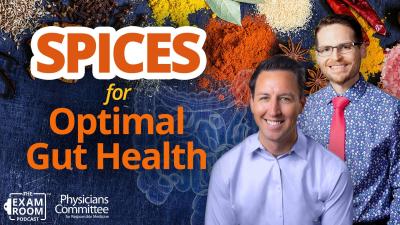Gut Bacteria: The Good, the Bad, and the Ugly

The bacteria living in our gut performs many functions, such as controlling metabolism, immune function, and maybe even our thoughts and moods. How can these tiny cells be so powerful in controlling human health? It depends on the types of bugs living in us and what we feed them.
Three Tips to Create a Set of Disease-Fighting Microbes
This is a guest blog by Physicians Committee associate director of diabetes nutrition education Meghan Jardine, M.S., M.B.A, R.D.N., C.D.E.
The bacteria living in our gut performs many functions, such as controlling metabolism, immune function, and maybe even our thoughts and moods. How can these tiny cells be so powerful in controlling human health? It depends on the types of bugs living in us and what we feed them.
To cultivate a set of disease-fighting versus disease-spreading microbes, move plant-based foods like vegetables, especially leafy greens, legumes (beans, peas, lentils), and whole grains to the center of your plate. Avoid meat and other high-fat, animal-based foods.
If you’re not sure where to start, follow this three-step plan for a thriving microbiome:

Step 1: Eat More Vegetables. When it comes to championing optimal health and slashing the risk for disease, dark leafy green vegetables take home the gold. A new study finds that the sugar (sulfoquinovose) in leafy greens such as spinach, kale, and watercress feed healthy bacteria that live in our digestive tracts, or gut. This bacteria flourishes and crowds out unhealthful varieties, while secreting bactericides that kill off harmful bacteria. Plus, good habits pay off. A 2015 study from RUSH University shows older adults who eat at least two servings of leafy greens each day reduce their risk for dementia.
Step 2: Add Beans to Your Diet. Beans, a member of the legume family, are a dieter’s best friend, since they are rich in fiber, leaving us feeling full, with just 115 calories per 1/2-cup serving. Legumes also have an amazing effect on our gut bacteria. The fiber in beans is not digested in the small intestine. When it gets to the large intestine beneficial bacteria are waiting. They ferment the fiber and release short chain fatty acids (SCFA), which provide all kinds of benefits. SCFA help our body absorb essential minerals (calcium, zinc, magnesium), increase satiety (improving weight loss), decrease inflammation, reduce the risk of colon cancer, prevent and treat diabetes, and may even reduce the risk of asthma.
Step 3: Avoid meat, dairy, eggs, and fatty foods, which are high in calories and associated with insulin resistance. This can lead to type 2 diabetes and other forms of chronic disease. Here’s how it works:
Animal products promote the growth of detrimental bacteria and result in the release of toxic chemicals that are harmful to our health. Like carbohydrates, proteins are fermented by the bacteria living in the large intestine. Fermentation of protein causes a release of toxic metabolites (ammonia, phenolic compounds, and amines) that promote the formation of tumors (colon cancer), and increase the risk of inflammatory bowel disease, ulcerative colitis, schizophrenia, and liver problems. Animal protein from meat, eggs, and dairy products are metabolized in the gut and once absorbed into the body to release a metabolite (trimethylamine-N-oxide), which has been linked to cardiovascular disease.
Fats are mostly absorbed in the small intestine. Studies have demonstrated that fat in the diet reduces the production of those beneficial short chain fatty acids by inhibiting the growth of healthy bacteria. Fats also need bile to be digested and absorbed. Bile is secreted from the liver into the small intestines. So now the bacteria also have to metabolize this bile and that causes a growth of “bile-tolerant” bacteria. Bile-tolerant bacteria have been associated with inflammatory bowel disease, higher levels of inflammatory factors in the blood, and may also increase the risk of liver cancer.
The good news is we have 40 trillion bacteria living inside our body. With a few modifications it’s easy to create a new biological system to enable our body to focus on larger tasks, like climbing Mount Everest or helping our children with their science project, instead of constantly combating pathogens.
Partner these tips with gut-friendly pre- and probiotics to give your body the fuel it needs to succeed.
Meghan Jardine, M.S., M.B.A., R.D., L.D., C.D.E., is the associate director of diabetes nutrition education for the Physicians Committee for Responsible Medicine, and works to develop programs to educate physicians, health care professionals, and the public about nutrition as preventive medicine.








